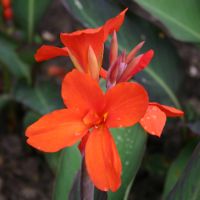Our catalogue of cannas for 2025 is shown below. We will modify this catalogue as the year progresses.
Our website may refuse to accept an order of more than one or two plants of particular varieties. We are not in the business of providing multiple quantities of each variety. Our role is to make available a wide range of varieties, not a large quantity of any particular variety.
What we sell are small plants, or a rhizome with new roots and at least one actively growing new shoot. Each plant that we sell is individually selected to be of a quality that we would like to receive ourselves if we were the customer. That is not always an easy task to achieve, particularly in the winter months. But we try to ensure that each plant we sell has at least the potential to be a credit-worthy plant.
These cannas should be potted-up as soon as received, well watered, and given a little TLC (tender loving care) until they become established. We recommend not planting them outside until mid May in most areas. Customers purchasing cannas in winter should grow them under glass and in a frost-free environment until spring. These are growing plants and are not suitable for onward storage through winter. Customers that don't have facilities for growing cannas through the winter are advised to purchase plants in the spring/summer. Please note that we do not take forward orders, ie customers placing and paying for an order to be delivered later in the season.
Please note that we do not sell dormant rhizomes. In nature cannas grow in the tropical parts of central and south America, and in the West Indies. These countries rarely if ever experience frost, and so cannas never become dormant. If forced into dormancy, many rhizomes die. Many customers will already have noticed that canna rhizomes sold in small packets of dry peat in garden centres are often already dead.
Our pricing policy is that we charge a little more for varieties that are more trouble for us to propagate, which generally are the bigger varieties, or for varieties that we are relatively short of.
We prefer customers to order on-line where possible (Our websites are encrypted and fully secure). The sale is then fully documented and archived, and we don't need to handle credit card information (which is securely handled by our Shopping Cart provider). We despatch cannas as soon as ordered where practical.
Callers to our nursery are welcome by arrangement, and we sometimes have a bigger selection in a wider range of sizes than is available online.
We are not able to send cannas outside mainland UK because of the cost and/or difficulty of obtaining export/import documentation.
This business is owned by Keith and Christine Hayward. We also hold the National Collection of cannas under the auspices of Plant Heritage.

|
Book
|
New for 2025, Published by Cannifer Ltd. 126 pages. 160 varieties described and illustrated. A gallery of cannas in parks and gardens. Sections on botany, taxonomy, cultivation. winter care, pests and diseases. Breeding new varieties, and more.
|
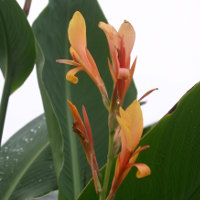
|
'Annei'Syn: 'Omega' (USA)
Price: £14.00
|
Height: Very tall, 2.5m+.
Granted the prestigious RHS "Award Of Garden Merit", AGM, in the RHS Canna Trial of 2002. It is the tallest of the canna garden cultivars, and truly spectacular, with large, lance shaped glaucous leaves, and delicate apricot flowers. Extremely vigorous, it soon produces a large clump. |
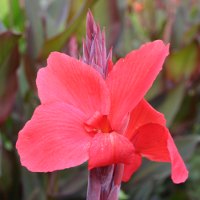
|
'Assaut'Price: £14.00
|
Height: Tall (to 2m) A heritage variety, and one of the best. |
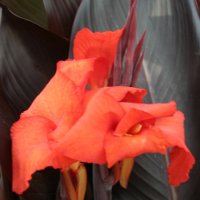
|
'Australia'Price £14.00 each
|
A tall and slender plant. May sometimes need staking. foliage: Very dark shiny chocolate colour.
A heritage variety.
|

|
'Bird of Paradise'Price £14.00 each Out of stock |
Very tall (2m).
Spidery pink flowers. Young plants are very thin, about the shape and size of a pencil. Note: this is not the Strelitzia 'Bird Of Paradise'. |
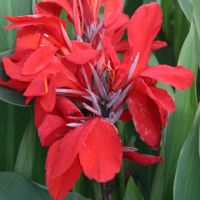
|
'Brilliant'Price: £12.00 each
|
Height: Medium A relatively short canna with intensely red flowers and narrow lance shaped green foliage with a dark edge. This variety has small rhizomes. It is very bushy and produces many flowering stems. |
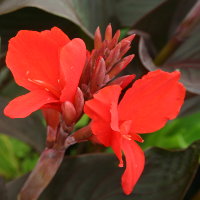
|
'Cannova Bronze Scarlet'Price: £12.00 each.
|
'CANNOVA' is a range of cannas bred by the Japanese company Takii, and marketed by their Dutch subsidiary. The first 3 varieties were introduced in 2014, since when more have been added. Some are excellent varieties; Cannova Bronze Scarlet and Cannova Yellow have featured as centrepiece plants at Kew Gardens. Some are excellent and distictive, including Cannova Mango and Cannova Bronze Peach |
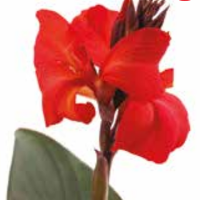
|
'Cannova Bronze Orange'
|
Height: Medium Available for the first time in 2017. Similar to Cannova Bronze Scarlet except for a more orange flower |
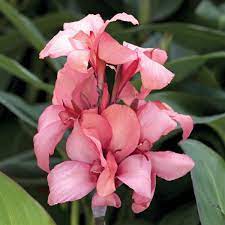
|
'Cannova Bronze Peach'
Out of stock |
Height: Medium A new member of the Cannova family, available for the first time in 2022.
|

|
'Cannova Mango'Price: £12.00 each
|
Height: Medium A distinctive and attractive variety, with nicely shaped flowers in a peachy shade of pink. |
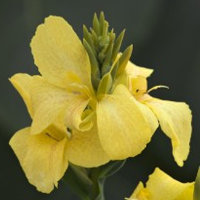
|
'Cannova Yellow'Price: £12.00 each
|
Height: Medium |
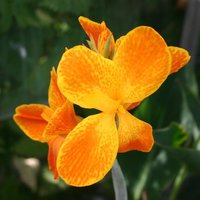
|
'Carnaval'Price: £10.00 each Out of stock |
Height: Medium An old French variety, hence the spelling 'Carnaval' |

|
'Centenaire de Rozain Boucharlat'Price £12.00 each
|
Height: Medium An old French variety, with true crimson/pink flowers. Bushy growth |
'Corsica'
Price £12.00 each
|
Height: short
One of the original heritage "Holiday Island" series. We don't have 'Tenerife'. If anyone has it, please send us a sample.
|
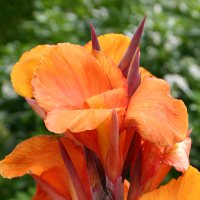
|
'Durban'Also known as 'Phasion', Tropicanna (TM). Price: £16.00 each
|
Height: Medium
RHS AGM Award 2002.
We fought a legal battle to free it from Plant Breeders' Rights and make it available for anyone to sell. For details see here To retain the colour of the foliage, it is better grown in some dappled shade (actually, this is true of all cannas with brown or red leaves). another photo |
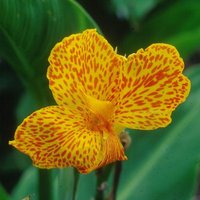
|
'En Avant'Price £12 4 |
Height: Medium A heritage variety There are a number of cannas having yellow flowers with red spots, but this is the "classic" and in our opinion the best. |
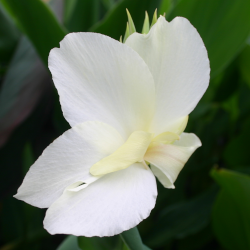
|
'Ermine'Out of stock |
Height: Short/Medium In our opinion 'Ermine' and 'Alaska' are identical, but we keep them separate in our stock.
|

|
'General Eisenhower'Also known as:
Price £14.00 each
|
Height: Tall
RHS AGM Award 2002. Dark bronze well-shaped foliage. Well-shaped orange/red flowers. |
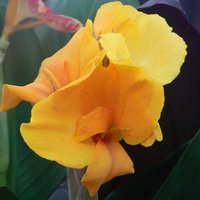
|
'Golden Orb'Price: £14.00 each
|
Height: Medium
An unusual variety which combines a golden flower with bronze foliage. Large, well shaped flowers on a well proportioned plant with heavy foliage. One of our best varieties. Bred by English plant breeder Jim Ranger who had a nursery at Arborfield, near Reading. He was a breeder of azaleas, but when he reached the age of 70 he said "when you get to 70 you can't be waiting 4 years to see a new flower", so he turned to cannas, where you see the benefit of your labour the following year. He did his breeding the professinal way, keeping a stud book, so he knew exactly what had had crossed with what. |

|
'Gran Canaria'Price £14.00 each
|
Height: Short/Medium A member of the heritage "Holiday Island" Series |
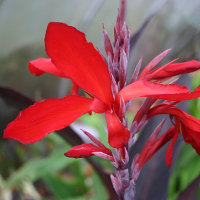
|
'Herman'Price £14.00 each
|
|

|
'Intrigue'Price £14.00 each
|
Height: Tall, 2m
A tall canna with dark brown narrow lanceolate leaves. Basically a foliage plant but with rather nice but small orange flowers. Sometimes confused with 'Mystique', which is exactly the same foliage and shape plant but with red flowers.
|
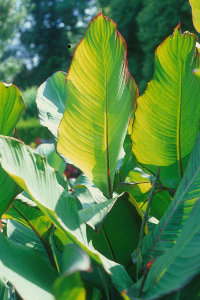
|
'Musifolia Grande'Syn: 'Musifolia', 'Grande' Price: £16.00 each Out of stock |
RHS AGM Award 2002. The banana leaf canna. A giant variety, over 2 meters. Green leaves with red veins and edges, and red stems. Suitable for the larger garden, National Trust properties etc. It rarely flowers in the English climate because by the end of summer it has not reached its full height. The flowers are small orange species-type. |
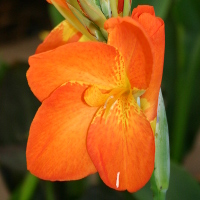
|
'Orange Punch'Price £14.00 Each Out of stock |
Height: medium 1.5 mtrs
A favourite at RHS Wisley Garden, where it has been featured in floral displays for the past few years. |
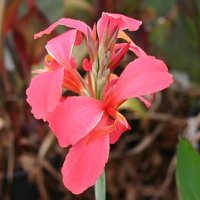
|
'Perkeo'Syn: 'Fatamorgana' Price £14.00 each
|
Height: Medium
Also known as 'Fatamorgana' |
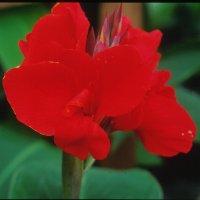
|
'President'Syn: 'Mr President'Price: £14.00 each
|
Height: Medium
A sturdy plant of medium height, with fleshy pale green foliage and large scarlet flowers. Much beloved of London parks in years gone by. |
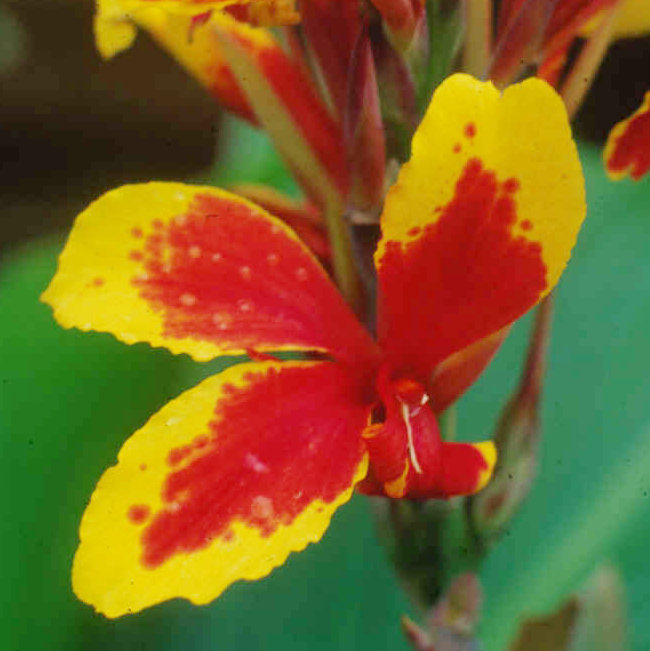
|
'Queen Charlotte'Also called 'Konigin Charlotte', 'Reine Charlotte' Price £14.00 each Out of stock |
Height: Medium
An old variety, bred in Germany. |
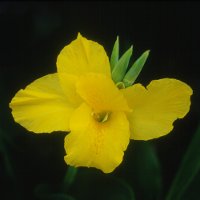
|
'Richard Wallace'Syn: C. lutea Price £12.00 each
|
Height: Medium
An extremely vigorous canna which produces masses of new shoots each year. |
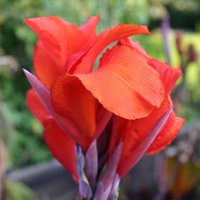
|
'Roi Humbert'Syn: 'Red King Humbert' Price £14.00 each
|
Height: very tall
An impressive plant for the herbaceous border. The flowers remain somewhat funnel-shaped. |
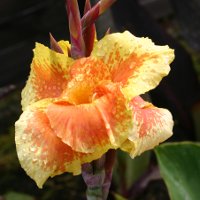
|
'Roma'
Price: £12.00 each Out of stock |
Height: Medium
Large flaccid flowers. An "Italian Series" canna bred around 1900. There are several similar varieties, and we are not exactly sure of the name, particulatly since the patterning can be variable - some flower have more yellow, and some less. If anyone has an opinion on this please let us know. |
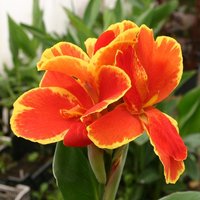
|
'Rosemond Coles'Price: £14.00 each Out of stock |
Height: Medium Although we say "medium height" it is actually a stocky plant with thick bright green foliage, and large heavy flowers which are red on the front and yellow on the reverse. |
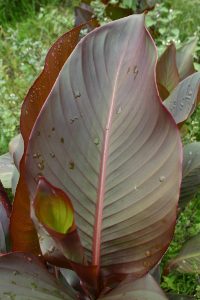
|
'Russian Red'Price £14.00 each.
|
RHS AGM Award 2002. A giant variety, 2 mtrs+, with very dark reddish bronze foliage. Small orange flowers. Suitable for the larger garden, National Trust properties etc. We identified this variety as an improved version of C. indica 'Purpurea' (it has bigger and darker leaves). The old variety 'Rubra Superbissima' is identical and may be the same. Very large apple-shaped rhizomes. We believe one of the varieties used for food. We've tried it, but it is not to our taste, and rather stringy. We submitted it to the 2002 RHS Canna Trial where it received the RHS AGM Award. 'Purpurea' was submitted to the same trial by the RHS itself, and failed to win an award. Nuff said!
|
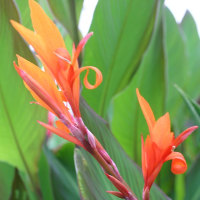
|
'Society Belle'Price £14.00 each
|
RHS AGM Award 2002. An old variety with a new name and an interesting history. In 2002 RHS Wisley Garden submitted a distinct but un-named cultivar to the canna trial being conducted that year in their trials Area. It was a variety widely grown and even naturalised in the wilder parts of the garden. It had no variety name so they simply called it C. indica cultivar. Within the few summer months of the trial, the 3 rhizomes that they planted grew into an enormous clump, and so impressed the judges that they awarded it the coveted AGM Award. The following quotation is from the RHS Trial Report published in September 2003: "An excellent foliage plant. The attractively translucent large paddle shaped leaves are green with a fine purple margin and dark stem. Well furnished from the base. Flowers are insignificant and bright red". This variety then retreated into obscurity, but continued to be grown as a naturalised plant in the RHS Garden. Pan forward to 2013. We had acquired specimens of this plant from the RHS, and we felt that it deserved to be marketed commercially. So we approached the RHS and suggested that a plant with an AGM award should be given a variety name. The RHS duly gave it the variety name 'Society Belle'. We agree with the RHS report except that that the flower colour is orange not red. This must be an editorial error because they correctly state the colour in the technical part of the report. We add that it is distinct from other big foliage cannas such as 'Musifolia Grande' (ie it is not reminiscent of a banana plant). It is also distnct from fully green leaved varieties such as 'Marabout', and from the fully bronze leaved cannas such as 'Russian Red' and 'Purpurea'. |
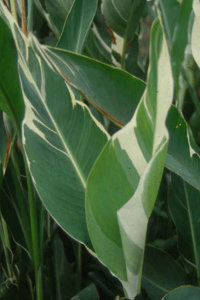
|
'Stuttgart'Price £14.00 each Out of stock |
A very unusual and distinctive canna. One of the tallest cannas, up to 2.5 meters, with narrow glaucous leaves variously striped and splashed with white. Smallish apricot flowers. The foliage always becomes disfigured by some white areas turning brown, and there seems to be no way of preventing this. Certainly, growing them in the shade doesn't work and neither does high-potash fertiliser, or feeding magnesium (eg Epsom salts) which is sometimes recommended. But even so, it is so vigorous that this minor fault may be overlooked. another photo |
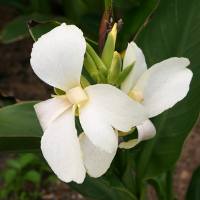
|
'Tropical White'Price: £12.00 each
|
Height: Short
There are not many white cannas and this is the only one that is short. It is also a good shade of white. |
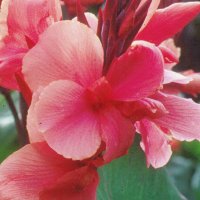
|
'Whithelm Pride'Price £12.00 each Out of Stock |
Height: Medium
RHS AGM Award 2002. The photo below is of a single plant and was taken at the 2002 RHS Canna Trial.
|
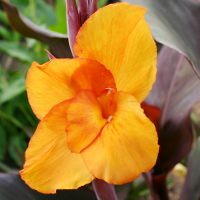
|
'Wyoming'Price: £14.00 each Out of stock |
Height: Very tall, over 2 mtrs
RHS AGM Awards 1906 and 2002. An old heritage variety which is one of the all-time favourites.
|
This is a range of 4 varieties which are intended to be grown as water plants. They grow with the roots and crown totally immersed in water, but they can be grown equally well in the garden border, and seem just as drought-hardy as other cannas. They are all tall plants (2 metres).
They were bred in America (at Longwood Gardens, Pennsylvania) from C. glauca which is always found in shallow water. Like C. glauca, they all have narrow lance shaped glaucous (bluish) foliage, and attractive rather spidery flowers. There are 4 varieies: 'Ra' (yellow), 'Erebus' (pink), 'Endeavour' (red), 'Taney' (orange). All are named after ships (Erebus and Taney are American warships).
'Ra' is the most popular, followed by 'Erebus', and both were awarded AGM at the 2002 Wisley Canna Trial. We served on the Trials Committee (status Technical advisors as owners of the UK National Collection). 'Ra' was very popular with the Committee and was awarded AGM ststus as soon as the first flower opened. 'Erebus somewhat later. In our opinion 'Endeavour' should also have been awarded AGM. 'Taney' is not very good (though beauty is in the eye of the beholder).
In the Britich climate, Water Cannas usually die if left in the outdoor pond over winter. The rhizomes are very slender and often die during the winter even in glasshouses if allowed to go dormant. For this reason we recommend taking them out of the water and growing them through the winter as plants in a frost-free greenhouse. They are happy not standing in water.
Occasionally other canna varieties varieties are encountered with the prefix "Water Canna". In our opinion "Water Canna" refers to these four varieties bred at Longwood Gardens.
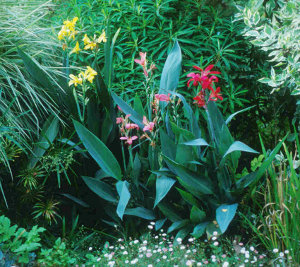
Photo of water cannas 'Ra', 'Erebus', 'Endeavour' growing in water
(The pond is hidden)
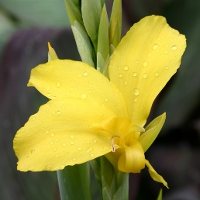
|
WATER CANNA 'Ra'Price: £12.00
|
Height: Very Tall
RHS AGM Award 2002. |
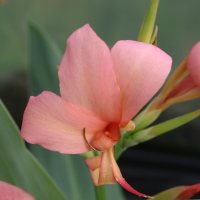
|
WATER CANNA 'Erebus'Price: £12.00 each
|
Height: Very tall
RHS AGM Award 2002.
|
© Copyright Cannifer Ltd 2010 - 2025

